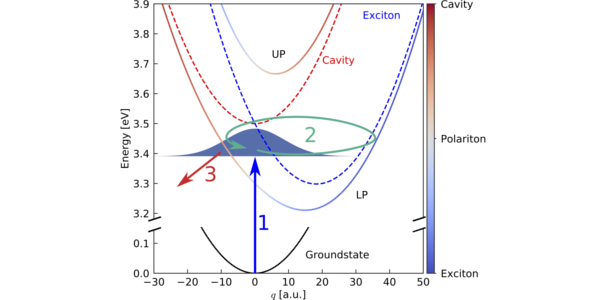Polaritonic Molecular Clock: Listening to Molecules
Article: published in Nature Communications by R. E. F. Silva, Francisco J. García-Vidal and Johannes Feist, IFIMAC researchers and members of the Theoretical Condensed Matter Physics Department.
The motion of atoms in a molecule typically occurs on the femtosecond timescale (10-15 s). The standard technique used to study chemical reactions at these timescales is pump-probe spectroscopy, where first an ultrashort pump laser pulse initiates the dynamics in the molecule and, some time later, an ultrashort probe laser pulse is used to obtain information about the current state of the molecule. However, the information obtained in these approaches is always somewhat indirect. If you imagine the molecule as a musical instrument and the laser pulses as short sound pulses, these approaches correspond to monitoring the change in the sound frequencies that the instrument responds to when it has been struck by a first sound already (this is known as transient absorption spectroscopy), or even to using such a strong second pulse that it blows apart the instrument, and trying to understand its motion before falling apart by measuring the pieces that fly away. These experiments are then repeated many times with different time delays between the pulses, to construct something akin to a movie of the molecular motion after it has been excited. One important reason that these approaches are used is that simply “listening” to the molecule, i.e., measuring the light that it emits after the first pulse, normally does not provide the required information. The fundamental reason for this is that a molecule only couples quite weakly to light, which has two main consequences: First, the amount of light that is emitted is typically quite low (making it hard to “hear” the molecule), and second, it takes a long time for the light to be emitted so that even if you can measure it, it is produced at times long after the interesting motion has taken place.
A theoretical proposal by a group of researchers from the Departamento de Física Teórica de la Materia Condensada and the Condensed Matter Physics Center (IFIMAC) at the Universidad Autónoma de Madrid now provides a way to resolve both of these problems at the same time and make it possible to listen to the molecule directly in those first few crucial tens of femtoseconds. The basic idea of this work is to place a molecule in a nanoplasmonic cavity, where the strong coupling between the molecule and the electromagnetic modes of the cavity transforms the molecule into a “loudspeaker”. The nanoplasmonic cavity in this case acts both as a resonator that changes the “sound” of the molecule and as an amplifier that makes it possible to “hear” the molecule. In the article, the authors show that ultrafast molecular dynamics can be traced with femtosecond resolution by looking at the photon emission by the cavity, which only happens when the molecular vibrational wavepacket is close to a position where the molecule and the cavity are in resonance with each other. In this way, the setup acts like a clock that measures how long the molecule takes to reach a given position. In particular, the authors show that this idea works in the regime of strong light-matter coupling, where the molecule and the cavity interact so strongly that their excitations become hybrid light-matter states known as polaritons. In this regime, this novel technique could provide direct insight into the modification of molecular motion induced by polariton formation. This approach could open the window for experimental and theoretical advances in the way we explore ultrafast chemical dynamics, paving a new way to combine femtochemistry and molecular polaritonics using plasmonic nanocavities. [Full article]



















